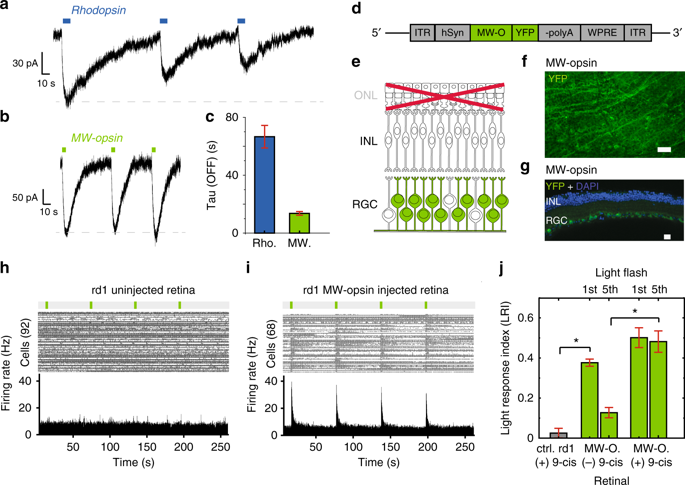当前位置:
X-MOL 学术
›
Nat. Commun.
›
论文详情
Our official English website, www.x-mol.net, welcomes your
feedback! (Note: you will need to create a separate account there.)
Restoration of high-sensitivity and adapting vision with a cone opsin.
Nature Communications ( IF 14.7 ) Pub Date : 2019-03-15 , DOI: 10.1038/s41467-019-09124-x Michael H Berry 1, 2 , Amy Holt 1 , Autoosa Salari 1 , Julia Veit 1, 3 , Meike Visel 1 , Joshua Levitz 1, 4 , Krisha Aghi 3 , Benjamin M Gaub 3, 5 , Benjamin Sivyer 2, 6 , John G Flannery 1, 3, 7 , Ehud Y Isacoff 1, 3, 8
Nature Communications ( IF 14.7 ) Pub Date : 2019-03-15 , DOI: 10.1038/s41467-019-09124-x Michael H Berry 1, 2 , Amy Holt 1 , Autoosa Salari 1 , Julia Veit 1, 3 , Meike Visel 1 , Joshua Levitz 1, 4 , Krisha Aghi 3 , Benjamin M Gaub 3, 5 , Benjamin Sivyer 2, 6 , John G Flannery 1, 3, 7 , Ehud Y Isacoff 1, 3, 8
Affiliation

|
Inherited and age-related retinal degenerative diseases cause progressive loss of rod and cone photoreceptors, leading to blindness, but spare downstream retinal neurons, which can be targeted for optogenetic therapy. However, optogenetic approaches have been limited by either low light sensitivity or slow kinetics, and lack adaptation to changes in ambient light, and not been shown to restore object vision. We find that the vertebrate medium wavelength cone opsin (MW-opsin) overcomes these limitations and supports vision in dim light. MW-opsin enables an otherwise blind retinitis pigmenotosa mouse to discriminate temporal and spatial light patterns displayed on a standard LCD computer tablet, displays adaption to changes in ambient light, and restores open-field novel object exploration under incidental room light. By contrast, rhodopsin, which is similar in sensitivity but slower in light response and has greater rundown, fails these tests. Thus, MW-opsin provides the speed, sensitivity and adaptation needed to restore patterned vision.
中文翻译:

用视锥细胞恢复高灵敏度和适应性视力。
遗传性和与年龄相关的视网膜退行性疾病会导致视杆细胞和视锥细胞光感受器进行性丧失,导致失明,但下游视网膜神经元不会受到影响,这些神经元可以作为光遗传学治疗的目标。然而,光遗传学方法受到低光敏感性或缓慢动力学的限制,并且缺乏对环境光变化的适应,并且没有被证明可以恢复物体视觉。我们发现脊椎动物中波长视锥蛋白(MW-opsin)克服了这些限制并支持弱光下的视力。 MW-视蛋白使失明的视网膜色素变性小鼠能够区分标准液晶电脑平板电脑上显示的时间和空间光模式,显示对环境光变化的适应,并在偶然的室内光下恢复开放视野的新物体探索。相比之下,视紫红质的灵敏度相似,但光响应较慢且衰减更大,因此未能通过这些测试。因此,MW-视蛋白提供了恢复图案视觉所需的速度、灵敏度和适应性。
更新日期:2019-03-15
中文翻译:

用视锥细胞恢复高灵敏度和适应性视力。
遗传性和与年龄相关的视网膜退行性疾病会导致视杆细胞和视锥细胞光感受器进行性丧失,导致失明,但下游视网膜神经元不会受到影响,这些神经元可以作为光遗传学治疗的目标。然而,光遗传学方法受到低光敏感性或缓慢动力学的限制,并且缺乏对环境光变化的适应,并且没有被证明可以恢复物体视觉。我们发现脊椎动物中波长视锥蛋白(MW-opsin)克服了这些限制并支持弱光下的视力。 MW-视蛋白使失明的视网膜色素变性小鼠能够区分标准液晶电脑平板电脑上显示的时间和空间光模式,显示对环境光变化的适应,并在偶然的室内光下恢复开放视野的新物体探索。相比之下,视紫红质的灵敏度相似,但光响应较慢且衰减更大,因此未能通过这些测试。因此,MW-视蛋白提供了恢复图案视觉所需的速度、灵敏度和适应性。













































 京公网安备 11010802027423号
京公网安备 11010802027423号